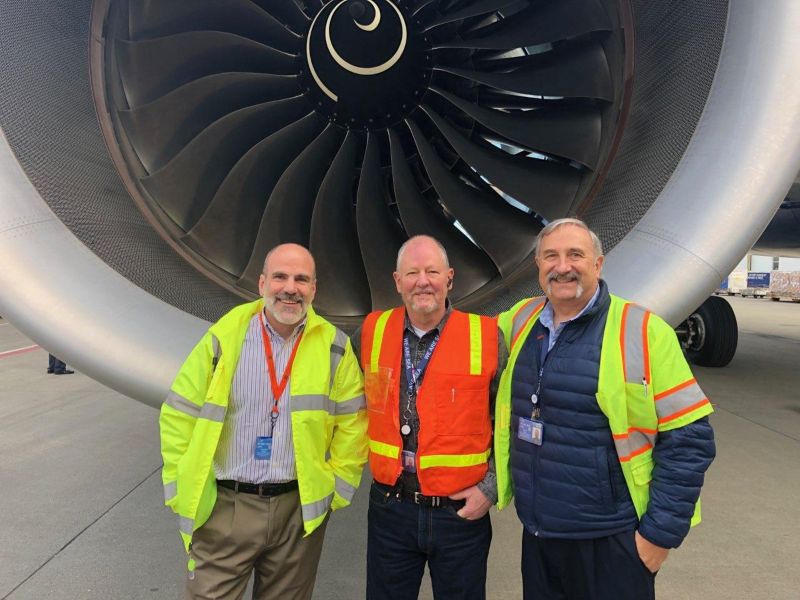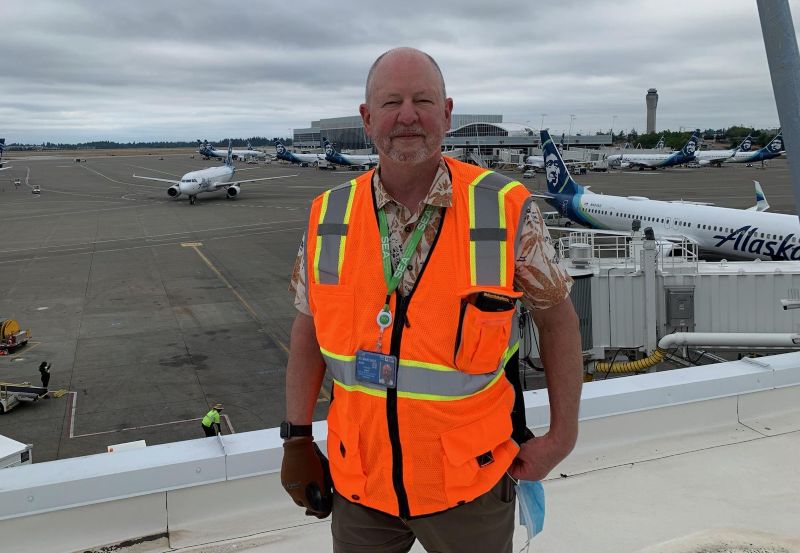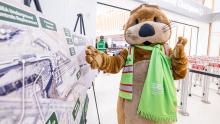
An Interview with Mark Coates by Anika Klix and Cathy Swift
You wouldn’t think that a 12-second event could change time, space, and history but the first controlled powered airplane flight launched by Orville and Wilbur Wright in Kitty Hawk, North Carolina on December 17, 1903 did just that. It opened up the world, joined us all into a global community, and started the aviation industry, which still fuels the economies of the travel, manufacturing, and logistics sectors. Aviation has been a primary driver of the Pacific Northwest economy since Boeing turned us into the Jet City in 1916.
Today we celebrate National Aviation Day on the birthday of Orville Wright and consider how the aviation industry has changed the world, our region, and the economy since that handcrafted airplane proved it was possible.
Aviation industry takes off
Fast forward to the modern aviation age. The Federal Aviation Administration (FAA) handles over 16 million flights (with more than 10 million passenger flights) a year. With 45,000 flights running a day there could be up to 5,400 aircraft in the sky at any time. The FAA has set up an infrastructure of 520 airport traffic control towers in the United States, staffed by more than14,000 air traffic controllers working at around 5,000 public airports and over 14,000 private airports. According to the United States Department of Transportation (USDOT), nearly 11 million US jobs are generated from the aviation industry.
We interviewed Mark Coates, Senior Manager of Airfield Operations, to learn about his work and responsibilities overseeing the airfield at Seattle-Tacoma International Airport (SEA), what he enjoys most about his job, and advice for anyone interested in breaking into the field of aviation.
How long have you been at the Port of Seattle and what's the best part of your job?
First of all, thank you for taking an interest in what I do. I have worked at the Port of Seattle for 29 years.
For me, the best part of my job is working with an amazing Aviation Operations team. Every minute of every day, we are working to ensure the safety of the traveling public. I enjoy the fast pace of the airport, the sound of aircraft, and even the smell of jet fuel! Every day brings new challenges and opportunities to learn, fix a problem, or improve a process to make it safer for everyone on the airfield. I’m proud and firmly believe there is no greater social responsibility then to keep the public safe. The customers that I serve are the passengers at SEA. I am a public servant responsible for public trust and take the heavy weight of that responsibility very seriously.
Another thing I love is that the aviation industry is ever-changing, and I learn something new every day. There is no ‘lastly’, because I could keep listing what I love about my job, but it is working with all levels of the organization that makes me know I am supported.

Tell us about the types of jobs at the airport and how they function.
The aircraft’s location on approach to the airport and on the airfield determines the people involved and the functions required. The primary and most important function is to separate aircraft, first and foremost. Whether airplanes are in the sky, on the airfield, or at the gates it’s essential to keep them separated for safety and efficiency.
- When the plane is more than five miles away from the airport, the Federal Aviation Administration’s Air Traffic Controllers are monitoring the plane’s progress and guiding the pilot.
- As the plane comes within five miles of the airport, the FAA Local Control team takes over to guide the plane to a runway landing.
- Once the plane has landed on the runway, FAA Ground Control controls aircraft on the taxiways. Ground Control transitions them from the runway to the ramp and the terminal gate.
Ramp Control at SEA uses FAA Certified Controllers that are contracted by the Port of Seattle to control the Ramp and Gate Area. That’s where the baggage is put on the planes, so it’s vital to control the movement of airplanes in and around the gates.
- Howstuffworks.com has a great description of the Air Traffic Control process, similar to a zone defense of a basketball team.
What are some of the biggest challenges you have faced and currently face in operating the airfield?
I have overcome many challenges in my life but probably the biggest was the training and getting Certified as an FAA Air Traffic Controller. When I was young, I had learning disabilities such as dyslexia, trouble reading, very poor hearing, stuttering, and pronunciation issues and I am grateful for the help of many people along the way. Today, knowing that I am in a position where people count on me behind the scenes, even if they don’t know me, in a job that is serious in nature where there is zero margin for error, is not something I take lightly. Air Traffic Controllers are the “guardians of our skies” and I’m proud to have been an Air Traffic Controller early in my career. It is what ultimately led me to where I am today.

How did being an Air Traffic Controller prepare you for your current job?
Becoming an Air Traffic Controller was foundational. It gave me the confidence to know that I could achieve a goal that I thought was not achievable.
Once I finished my education, I moved into Airport Operations at Atlanta International Airport as an Airport Duty Manager. I was speaking at a conference on Aviation Airport Safety and I was approached by Charles Blood who ultimately had a 33-year career with the Port of Seattle and was at that time serving as the Director of the Airfield at Seattle-Tacoma International Airport. He asked me if I had been to Seattle before and I said no. He told me that soon they would be hiring for an Airfield Manager if I was interested. I came to the Port 29 years ago and the rest is history. Charles Blood was my mentor and I am grateful for his guidance over the years. I believe that mentorship is important and even now I have a coach and people I seek counsel from. My advice is to never stop learning and never stop teaching and developing people, find a mentor, and follow your passion. The Port has a great mentorship program called MEEM (Mentoring Everyone, Everyone Mentors) that I highly recommend.
How do people train for jobs in the aviation industry?
The aviation industry is very dynamic and varied, so there’s something for everyone.
We have more than 22,000 employees doing just about every job you can think of at SEA Airport. There are many jobs that are directly related to aviation like pilots, Air Traffic Controllers, Flight Attendants, cabin attendants, caterers, baggage handlers, gate agents, and aircraft mechanics.
There are also many jobs in the airport terminal — for instance, working in the retail stores and restaurants, running the airport lounges, or serving as customer service representatives to help people navigate to their gates. Also, custodians, security staff, bus drivers, car rental agents, and security staff to name just a few more.
Training depends on what path you choose, so following your passion is the best advice I can give. Community colleges offer aviation programs, but even if you are interested in becoming a paralegal, for example, you can get that degree and still work for the airlines or any aviation-related company or utilize many transferrable skills such as critical thinking. Having a degree in one area doesn’t limit you from transferring those skills to another area within the Aviation industry. Our Wildlife Management team is a great example — the airport has wildlife biologists on staff to keep travelers and wildlife safe.
What kind of skills do aviation-related jobs require?
At an airport you need to have an uncompromisable sense of safety.
My mantra is: inspect, detect, report, and correct.
This is the foundation of everything my Airfield operations team is responsible for. These fundamentals are similar to LEAN, Emergency Management, and basic effective management principles. My four goals are always to:
- Improve communications
- Reduce confusion
- Simplify the coordination
- Expedite the decision-making process
Additionally, someone interested in Aviation-related jobs at an airport, especially in operations, should always be aware of emerging technologies and innovations. If you have attended any of the Port’s Disruption Summits, you will know that there is technology already out there that will dramatically change the way SEA does business in the future. Some examples are Advanced Air Mobility, Drones, Surface Area Management, and Perimeter Intrusion Detection. We must be aware of, and prepared for, these changes to be able to pivot our current processes and seamlessly adapt in the future. Working at SEA also requires excellent communication skills, an awareness and knowledge of compliance, and aviation regulations. Experience in project management doesn’t hurt.
The sky’s NOT the limit
It’s an exciting time to be in the aviation industry, so here’s help finding your next job.
Federal aviation jobs
Jobs at SEA
Located in the main terminal of Seattle-Tacoma International (SEA) Airport, Airport Jobs is the primary recruiting tool and the principal resource for people seeking employment at the airport.
Airport Jobs provides free services to help you:
- learn about current job openings at SEA and local airport-related employers;
- meet with a career navigator;
- get help completing on-line job applications;
- get help with your resume and cover letters;
- learn job search and interviewing techniques;
- attend a hiring event for jobs at the airport
- find community resources for food, housing, education, and more.




